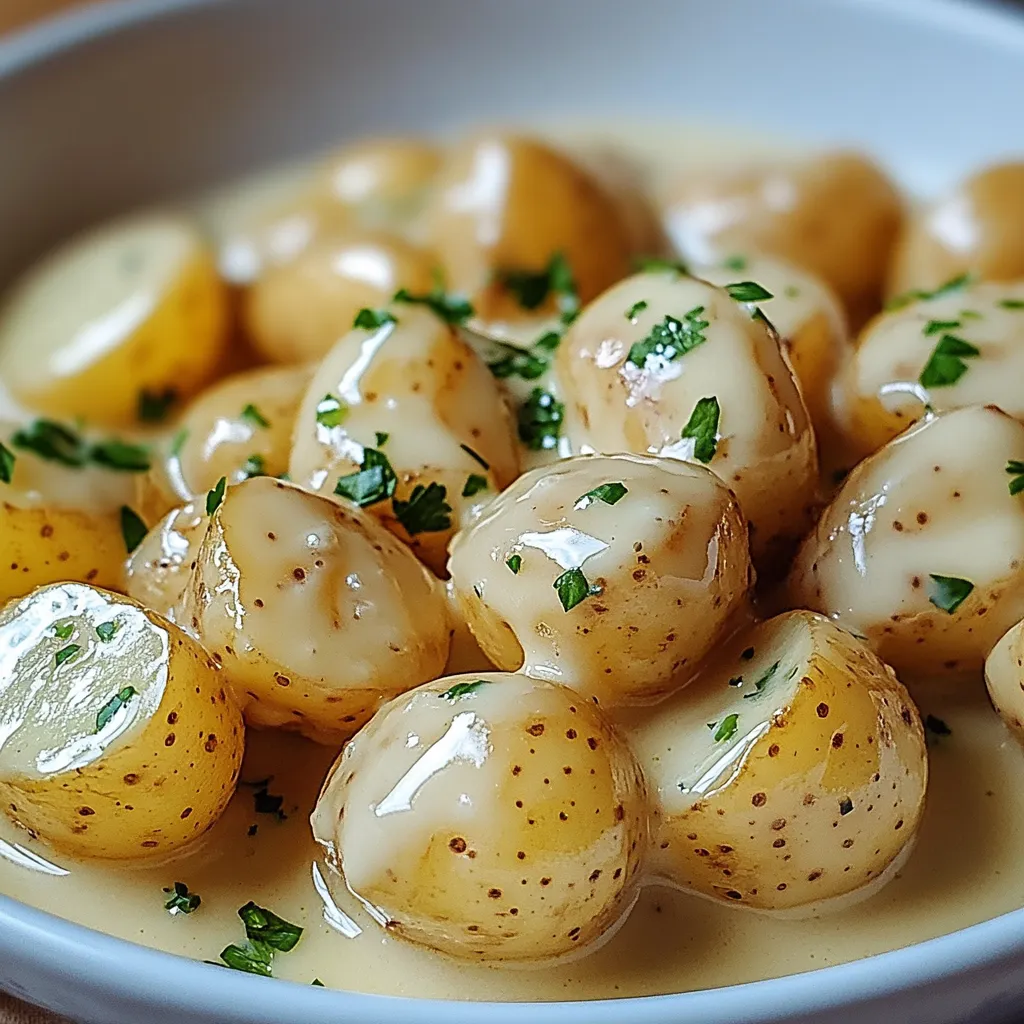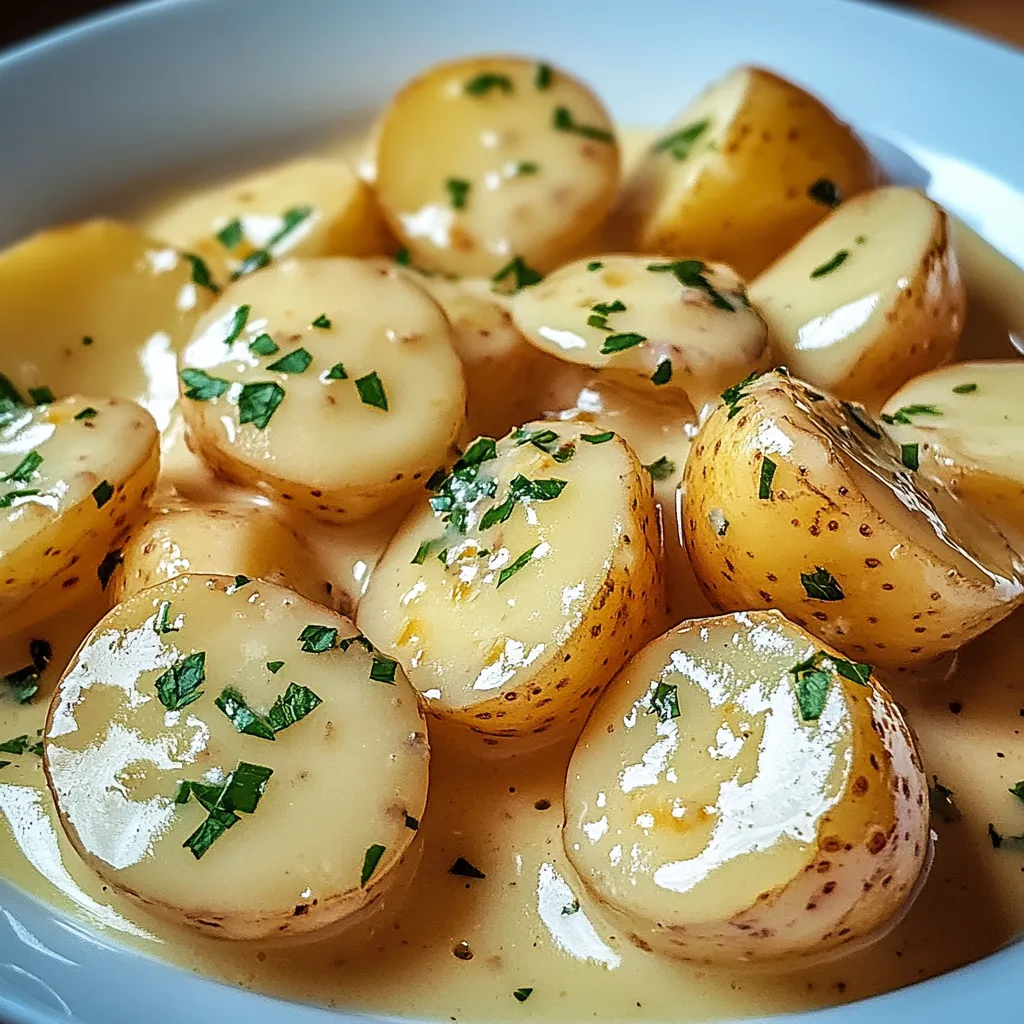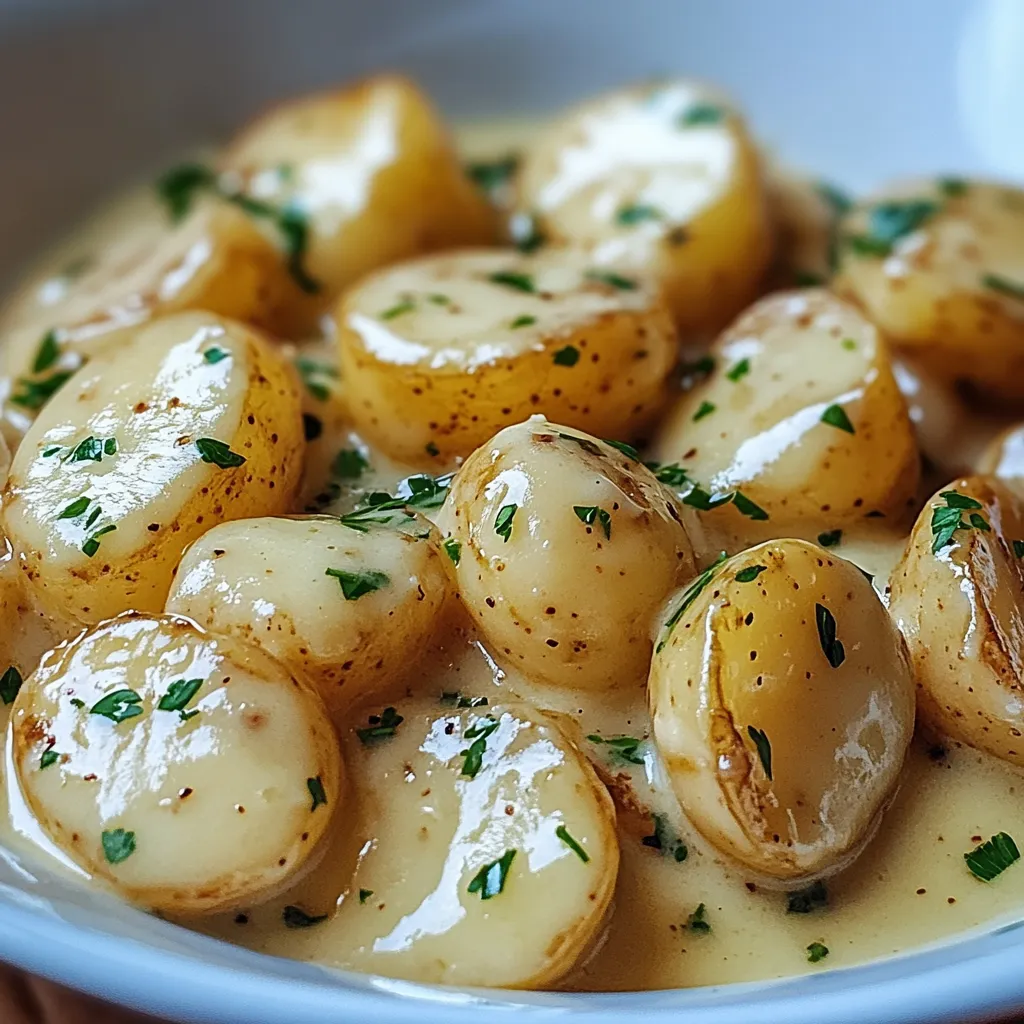 Save
Save
Creamy garlic sauce baby potatoes deliver a perfect balance of earthy potato flavor and rich, indulgent sauce that transforms this simple ingredient into something truly special. The tender baby potatoes absorb the garlicky sauce beautifully, creating bite-sized morsels of comfort food that work equally well as a side dish or the centerpiece of a meal. This versatile dish pairs wonderfully with everything from roasted chicken to grilled steak, making it a reliable addition to your cooking repertoire.
I've made this dish countless times for family gatherings, and it consistently disappears first from the buffet table. The way the baby potatoes soak up that garlicky cream sauce creates such a satisfying texture - firm enough to hold their shape but tender enough to melt in your mouth with each bite.
Essential Ingredients
- For the potatoes:
- Baby potatoes: Their thin skins and creamy interiors make them perfect for absorbing flavors
- Olive oil: Helps the potatoes develop a slightly crisp exterior before adding the sauce
- Salt and pepper: Enhances the natural earthy flavor of the potatoes
- Fresh garlic: Provides the backbone of flavor; fresh cloves offer superior taste to pre-minced options
- For the creamy sauce:
- Heavy cream: Creates the luxurious base for the sauce, coating each potato perfectly
- Butter: Adds richness and helps the sauce cling to the potatoes
- Garlic: Provides depth of flavor that infuses throughout the dish
- Fresh herbs: Brightens the rich sauce with aromatic notes
- Parmesan cheese: Introduces a savory, nutty element that complements the garlic beautifully
Cooking Instructions
- Preparation:
- Wash baby potatoes thoroughly and cut larger ones in half to ensure even cooking. Pat them dry completely to achieve better browning. Mince fresh garlic cloves finely to distribute their flavor evenly throughout the sauce.
- Initial Cooking:
- Heat olive oil in a large skillet over medium-high heat until shimmering. Add potatoes cut-side down and season with salt and pepper. Cook undisturbed for 5-7 minutes until the bottoms develop a golden crust. This initial searing creates a flavorful foundation for the dish.
- Sauce Creation:
- Reduce heat to medium-low and add butter to the pan. Once melted, add minced garlic and cook just until fragrant, about 30 seconds, being careful not to burn it. Pour in heavy cream, stirring to incorporate any browned bits from the bottom of the pan. This deglazing step captures all the developed flavors.
- Simmering Process:
- Allow the sauce to simmer gently around the potatoes, occasionally basting them with the thickening sauce. Cover the skillet and cook for 15-20 minutes, checking occasionally until potatoes are fork-tender but still hold their shape. The slow simmer allows the potatoes to absorb the garlic flavor while the sauce reduces to the perfect consistency.
- Final Touches:
- Sprinkle freshly grated Parmesan into the sauce, stirring gently until melted. Add chopped fresh herbs and adjust seasoning with salt and pepper. Allow the dish to rest for a few minutes before serving, which helps the sauce further thicken and flavors to meld completely.
 Save
Save
I discovered that using Yukon Gold baby potatoes specifically makes a noticeable difference in this recipe. My grandmother always insisted on using them for creamy potato dishes, and she was absolutely right - their naturally buttery flavor complements the garlic sauce perfectly, creating a more cohesive dish than russet or red potatoes can achieve.
Cooking Techniques
Understanding the cooking method options gives you flexibility based on your time and equipment. The stovetop method described above offers excellent control over the sauce consistency, allowing you to adjust heat and ingredients as needed. However, you can also prepare this dish in the oven by transferring the seared potatoes to a baking dish, pouring the prepared sauce over them, and baking at 400°F for 20-25 minutes until bubbling and golden. For the ultimate hands-off approach, slow cooker preparation works wonderfully - simply layer the raw potatoes with the sauce ingredients and cook on low for 4-5 hours until tender. The sauce develops a remarkable depth of flavor, though you may want to thicken it with a cornstarch slurry before serving.
Perfect Pairings
Complementary Proteins: These creamy potatoes create a beautiful foundation for roasted chicken, particularly herb-rubbed varieties that echo the flavors in the sauce. For special occasions, a medium-rare ribeye steak provides wonderful contrast to the creamy potatoes. Seafood lovers should try pairing with garlic butter shrimp for a decadent surf-and-turf approach that amplifies the garlic flavor profile. Vegetable Accompaniments: Balance the richness of this dish with simply prepared vegetables like roasted asparagus, steamed green beans, or a crisp garden salad with vinaigrette. The acidic elements in these sides help cut through the creamy sauce and refresh the palate between bites.
Customization Options
Flavor Adaptations: Create an herb-forward version by incorporating fresh thyme, rosemary, and parsley directly into the sauce. For Mediterranean influence, add sun-dried tomatoes and olives during the final cooking stage. Spice lovers can introduce red pepper flakes or a dash of smoked paprika for subtle heat and color. Dietary Modifications: For a lighter version, substitute half the cream with chicken broth and add a splash of lemon juice for brightness. Vegan adaptations work surprisingly well using coconut cream and nutritional yeast in place of dairy. Those watching carbohydrates can prepare this sauce with cauliflower florets instead of potatoes for a satisfying alternative.
Storage Solutions
Refrigeration Method: Store leftover potatoes in an airtight container in the refrigerator for up to three days. The sauce may thicken considerably when chilled, but this is normal and easily remedied during reheating. For best results, allow the container to come to room temperature for about 15 minutes before reheating to prevent thermal shock. Reheating Approach: Gently warm leftovers in a covered skillet over medium-low heat, adding a splash of milk or cream to restore the sauce's silky consistency. Stirring occasionally helps redistribute the sauce evenly without breaking it. Alternatively, microwave on 70% power in short intervals, stirring between each to ensure even heating without sauce separation.
Chef's Helpful Tips
- Allow potatoes to develop a golden crust before adding liquid ingredients for maximum flavor development
- Reserve a few tablespoons of starchy potato cooking water to help emulsify the sauce if it begins to separate
- Finish the dish with a squeeze of fresh lemon juice to brighten all the flavors and cut through the richness
- Let the finished dish rest for 5 minutes off heat before serving to allow the sauce to reach perfect consistency
After years of making this dish for family gatherings, I've found that the little details make all the difference. Taking the time to properly sear the potatoes before adding the cream creates layers of flavor that elevate this simple dish to restaurant quality. There's something deeply satisfying about watching guests close their eyes with that first creamy, garlicky bite - proof that sometimes the simplest ingredients, treated with care, create the most memorable food experiences.
 Save
Save
Common Questions About Cooking
- → Can I use regular potatoes instead of baby potatoes?
- Yes, you can use regular potatoes. Just cut them into 1-inch cubes so they cook in the same amount of time.
- → How do I store leftover creamy garlic potatoes?
- Store leftovers in an airtight container in the refrigerator for up to 3 days. Reheat in the microwave or oven until warmed through.
- → Can I make this recipe dairy-free?
- Yes, substitute the butter with olive oil, and use coconut cream and nutritional yeast instead of heavy cream and Parmesan.
- → What main dishes go well with these potatoes?
- These potatoes pair perfectly with roasted chicken, grilled steak, baked fish, or as part of a vegetarian spread with roasted vegetables.
- → Can I add herbs other than parsley?
- Absolutely! Try fresh thyme, rosemary, chives, or dill for different flavor profiles.
